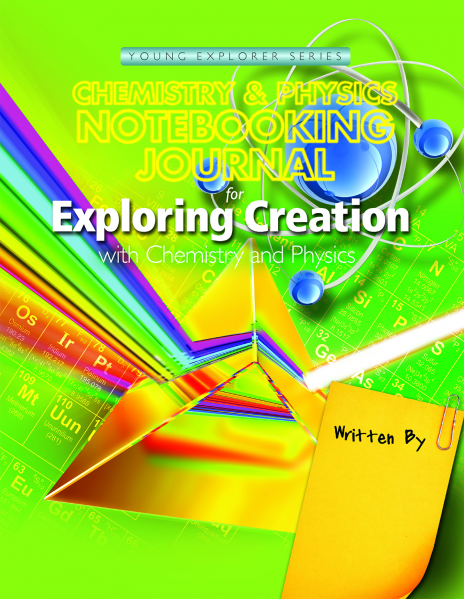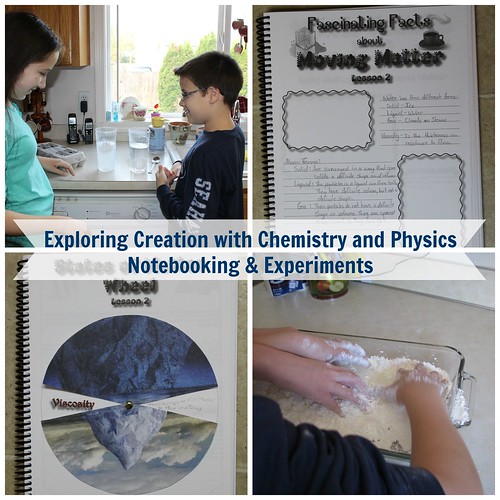Science--a subject that as a homeschool mom I had faced with dread. It seemed liked everything looked at was extremely boring and/or promoted evolution. About five years ago I discovered Apologia Educational Ministries Elementary homeschool science curriculum and found that science wasn't something to be dreaded anymore. The last few weeks I had the opportunity to review their newest book, Exploring Creation with Chemistry and Physics book and Notebooking Journal for upper elementary students (a Junior journal is also available for younger students).
Exploring Creation with Chemistry and Physics textbook and notebook journal written by Jeannie Fulbright and is for K-6 students. It introduces kids to chemistry and physics and follows a Charlotte Mason methodology with short lessons (if desired), narration, notebooking activities (or written narrations). The best part is that it comes from Biblical worldview that gives glory to God and shows confirmation to God as the Creator.
Topics covered include:
- Properties of matter
- Basic building blocks of life--atoms and molecules
- Laws of motion
- Laws of thermodynamics
- Energy
- Electricity
- Magnetism and more
The Exploring Creation with Chemistry and Physics is a colorful hardback book which is printed nice sturdy paper. There is a table of contents, an introduction, and a section on how to use the book. Each chapter is broken down in smaller sections that cover one specific concept. Throughout the readings there are "Try This!" sections which have you do small experiments that gives "hands on" experience in understanding a concept.
Midway through the lesson is a spot to stop and have your child narrate what they have learned so far. The chapter then continues as before. A chapter ends with a "What Do You Remember?" section that has specific questions to ask your child. The chapter is tied up with a notebooking activity and experiment or project.
At the end of the book is a supply list which lists everything you will need for each chapter's experiments. Most items needed are household items though some require some science equipment. The "Try This!" sections and experiments are easy to understand and for the most part easy to implement. Your child will have lots of opportunity to get "hands on" experience throughout each chapter.
There is also a course website available that has links to websites that enhance the subjects that you have read about. There is a small list for the whole book and then each chapter has a variety of links. This course website is password protected, but the password is available in the textbook.
The Exploring Creation with Chemistry and Physics Notebooking Journal is spiral bound. It starts off with a table of contents, note from the author, how to use this book, and a daily schedule included. The daily is broken down into a 28 weeks doing one chapter in a two week time period and two days a week.
Each chapter has a section titled "Fascinating Facts" which include lines for written narrations and places for the student to draw a picture. There is also sections for notebooking assignments, activities, and projects. Crossword puzzles cover vocabulary words and then there is a scripture included in printing or cursive for copywork.
In the back of the book there are cut and fold books craft activities that can be cut out and put together and then pasted on the page included for the book. The "Test It Out" section includes additional experiments along with book and DVD suggestions. There are then a few pages for a child to record their experiments by writing down what kind of experiments they did and what they learned from them.
Each chapter is ends with the "What Do You Remember?" section which has a list of questions for review. These questions can be done orally or used a written narration. This section is to help you child build retention as your child retells what they have learned.
I used this with my 7th & 5th grader. My kids are very familiar with Apologia's Elementary books since this is the only thing we have used for science. Even though I found Exploring Creation with Chemistry and Physics to be a more meatier book (as in the topic and amount of experiments) than the previous books, the set-up was the same and since I have done this for so long I have created my own schedule for working through Apologia's books.
I schedule one chapter for a two week period, but I spread the reading throughout 4 days a week rather than the suggested two. I think this helps keep the lessons short as Charlotte Mason recommended. I also had my kids take turns narrating after each section with the option of the non-narrating kid adding to the narration is they so desire. When the reading was done then they would enter their written narration in their notebooking journals. We also would do the "Try It!" experiments if we had the time and the items on hand.
Many times I found that we could read through the chapter in six days which was nice since I could go back and do an experiment that we missed due to time or not having items on hand. Also, this gave the kids a chance to catch up with any written narrations that they may have gotten behind in, do the crossword puzzle, copywork page, extra project, or make a mini book.
My daughter does not have any problems doing written narration so she just basically used the notebooking journal to record her narrations. She also did the copywork page and crossword puzzles.
My son isn't quite able to do written narrations on his own so many times I would write something on the white board and he would write it in his notebooking journal. For one chapter I just had him write the vocabulary words and their definitions for his written narrations and for another chapter he put together the mini book instead of the "Fascinating Facts" pages.
If any one can fail at experiments it is me, but I did give it a good shot. There are a lot more experiments in this book than in the others we have done and though we did many of the experiments, some days I ran out of time. I tried to just focus on the ones I felt that I could do with a small measure of success. I still think I only had a 50% success rate. You can't blame me for a lack of trying though!
I have to admit that the first two chapters presented a learning curve for my kids. Many of these concepts were new to them. (Remember science isn't my thing.) They are slowly starting to understand these new concepts and becoming more interested in them. I think of lot of this is due to the experiments that we have been doing.
Though this is recommended for K-6 I feel that Exploring Creation with Chemistry and Physics is a better fit for older elementary students and if you do all the activities and experiments in the textbook and notebooking journal a middle school student will have completed a very thorough science course.
I love that I am able to introduce my kids to chemistry and physic concepts in an easy to understand terminology, plus that is backed with a Biblical and creationist worldview that shows how God is the creator and how his Creation confirms it.
Apologia Education Ministries has available:
Exploring Creation with Chemistry and Physics $39
Exploring Creation with Chemistry and Physics Notebooking Journal $24
Exploring Creation with Chemistry and Physics Junior Notebooking Journal $24
Apologia Education Ministries has available:
Exploring Creation with Chemistry and Physics $39
Exploring Creation with Chemistry and Physics Notebooking Journal $24
Exploring Creation with Chemistry and Physics Junior Notebooking Journal $24







I loved your review, Beth! I agree that it would be well suited to older kids- my oldest is 7, and we had a bit of a rough go with with sheer amount of awesome information in this book. I can't wait to give it another go with him when he is 9 or 10!
ReplyDeleteHave a wonderful day.